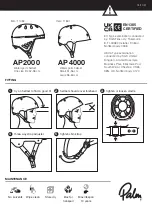
INSTRUMENT AND CONTROL FUNCTIONS
3-11
3
EAU67580
ABS
The Yamaha ABS (Anti-lock Brake
System) features a dual electronic con-
trol system, which acts on the front and
rear brakes independently.
Operate the brakes with ABS as you
would conventional brakes. If the ABS
is activated, a pulsating sensation may
be felt at the brake lever or brake ped-
al. In this situation, continue to apply
the brakes and let the ABS work; do
not “pump” the brakes as this will re-
duce braking effectiveness.
WARNING
EWA16051
Always keep a sufficient
d
istance
from the vehicle ahea
d
to match the
ri
d
in
g
spee
d
even with ABS.
The ABS performs
b
est with
lon
g
b
rakin
g
d
istances.
On certain surfaces, such as
rou
g
h or
g
ravel roa
d
s, the
b
rak-
in
g
d
istance may
b
e lon
g
er with
the ABS than without.
The ABS is monitored by an ECU,
which will revert the system to conven-
tional braking if a malfunction occurs.
TIP
The ABS performs a self-diagno-
sis test each time the vehicle first
starts off after the key is turned to
“ON” and the vehicle has traveled
at a speed of 10 km/h (6 mi/h) or
higher. During this test, a “click-
ing” noise can be heard from the
hydraulic control unit, and if the
brake lever or brake pedal is even
slightly applied, a vibration can be
felt at the lever and pedal, but
these do not indicate a malfunc-
tion.
This ABS has a test mode which
allows the owner to experience
the pulsation at the brake lever or
brake pedal when the ABS is op-
erating. However, special tools are
required, so please consult your
Yamaha dealer.
NOTICE
ECA20100
Be careful not to
d
ama
g
e the wheel
sensor or wheel sensor rotor; other-
wise, improper performance of the
ABS will result.
1. Rear wheel hub
2. Front wheel hub
1
2
UB33E0E0.book Page 11 Monday, December 1, 2014 4:49 PM
















































